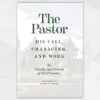Book Review: You Found Me, by Rick Richardson
Rick Richardson, You Found Me: New Research on How Unchurched, Nones, Millennials, and Irreligious Are Surprisingly Open to Christian Faith. InterVarsity Press, 2019.
Rick Richardson is a professor of evangelism at Wheaton College and the director of the Billy Graham Center Research Institute. He is Anglican, has a PhD from Trinity, and gained years of experience as a campus minister with InterVarsity Christian Fellowship. His book, You Found Me, is an attempt to motivate Christian leaders and churches to evangelize their communities through their local churches.
He offers two key insights. First, Christians should be more optimistic about the receptiveness of our unchurched neighbors. Recent “the sky is falling” statistics don’t consider the millions of unbelievers who would welcome an invitation to attend your church. Second, there is no one-size-fits-all program to grow your church with new converts. It will take building a culture of evangelism and that may look different depending on your context.
You Found Me provides some healthy directives to churches which have grown stagnant in their evangelism. His book also left me with several important questions for Richardson that discerning readers need to consider.
HEALTHY DIRECTIVES
First, be optimistic. Statistics about the decline of Christianity in America can be attributed to the decline of nominalism not serious Christianity. His statistics show “the religiously committed are as religious or more religious than ever” (41). Thus, many Christians are committed and evangelistic. Their existence should make us hopeful for the future of the church (36).
Moreover, our non-Christian neighbors are not as opposed to the Christian faith as you might think. Evangelism’s “biggest challenge,” Richardson argues, “is our own mindset and not the hostility or apathy of the larger culture” (49). Millennials are not leaving the fold at the rates many reports suggest. In fact, over half stay involved with their church. In short, don’t assume your neighbor will be hostile. Richardson’s comments here reminded me of a book by Rico Tice called Honest Evangelism. Yes, some of our neighbors are hostile to Christianity, but some are hungry for the Good News.
Second, build a culture of evangelism in your church. If Richardson’s interpretation of the state of Christianity today is the book’s most novel contribution, this directive is its most important. Richardson is a proponent of friendship evangelism: “As Christians, we must reach out in friendship to unchurched individuals around us and find ways to build trust in all arenas of life” (95). He rightly contends there is no “silver bullet” to get our churches filled with new converts (106). He calls for a more principled approach that works “across all different sizes and types of churches,” an approach that is “reproducible by the average pastor and everyday leaders in a church” (107).
He suggests we build this culture of evangelism by being a church that is thoughtful and warm to non-Christians who may attend a service. This includes pastors expecting unbelievers to be in attendance and addressing them in the messages (223). I appreciated Richardson noting it is appropriate for churches to target believers even as they are aware the unchurched are in their midst.
Richardson urges us to go beyond the walls of the church building and build bridges to our communities, serving where there is a need and sharing our faith at every opportunity. Very helpfully, he avoids prescribing a new program: “Note that we are not creating a new list of do’s and don’ts for you, though. We are asking that you realize and remember how you have been blessed and loved, and that you give only out of what you have received” (188).
Third, ensure leaders model evangelism. As a pastor myself, his chapter 6, “Modeling Outreach Others Can Imitate” greatly encouraged me. I know the temptation to limit my evangelism to my preaching, but I’m convinced of the need to hunt out opportunities to be salt and light in my neighborhood and community. I agree with Richardson when he writes, “It is very hard to lead what you are not living. The first step in becoming an evangelistic and missional church is to have a missional senior leader” (121). Church leaders are able to influence the culture of a church, we can and should keep the mission of the church front and center, even as our time is so often devoted to sermon prep, planning, and counseling.
Fourth, don’t let anything replace a verbal witness to Christ. Richardson bemoans the way some churches seek to meet physical needs without any attempt to share the gospel. “Churches that only engage in compassion ministry and never verbally proclaim their faith in Christ are the worst at reaching new people and growing their congregations as a result” (169). And it’s not just the lure of mercy ministry that can stifle proclamation, it’s the fear of seeming preachy. “Churches today are so sensitive to not turning people into projects that they draw back from being intentional about personal witness” (163).
Richardson’s call for churches to avoid self-centeredness and become focused on reaching the unreached is helpful. I do, however, have serious concerns and questions about Richardson’s work.
IMPORTANT QUESTIONS
First, what is Richardson’s view of the church? He encourages churches to plant “microchurches, small groups of two to ten, that can become the entry point into significant conversations for many nones and even ultimately become new congregations” (88). I see wisdom in gathering unbelievers together (if they are willing) to think and talk about Christianity with the hope they will one day join a church. But does Richardson consider this small group a church? I think so, but it’s unclear to me.
Moreover, more than once Richardson emphasizes the importance of belonging before believing: “People need to check out the Christian faith before they will commit. They need to belong before they can believe. So we need to be able to bring them into our community where they find acceptance and a safe place to explore their questions, concerns, and doubts” (192). I agree our congregations should be safe places to explore Christianity, but surely the New Testament idea of “belonging” is deeper and richer than feeling welcome—it is a covenant commitment to a community birthed out of regeneration, justification, and adoption into the family of God.
Perhaps I’m lingering on this question because of Richardson’s description of the spiritual journey of a woman who came to a “progressive Baptist church.” She “finally gave her life to Christ and is gradually changing in her moral convictions and practices” (94). I’m not sure what Richardson means by this. I believe sanctification is a process and that, in a sense, every Christian is in the process of his or her “moral convictions and practices” changing. But given Richardson’s commitment to “belonging before believing,” I walked away from this sentence unsure if Richardson thinks repentance is necessary for salvation and, therefore, if it is necessary for church membership.
Second, what is Richardson’s view of orthodoxy? He describes the Catholic and Orthodox as “other wings of the church” (21). If this is true, does he believe a faithful Roman Catholic or Eastern Orthodox is in need of evangelism from a Protestant? From reading the book as a whole, I would say yes. But based on this one statement, I would say no.
In his own, personal evangelism with his father, Richardson used a book by N. T. Wright and Marcus Borg called The Meaning of Jesus (90). Did he hand out this book to say both Wright’s and Borg’s understanding of Jesus is acceptable? Did he do it to prove to his father he understood the position of Borg but rejected it? Richardson doesn’t say, and an undiscerning reader could be led to think Borg is in the realm of orthodoxy—a tragic mistake.
Richardson repeatedly says it is important to be convictional. “I also believe,” he asserts, “in being deeply faithful to one’s tradition, Scripture, conscience, and God, and to communicating respectfully, thoughtfully, and with profound conviction one’s sense of truth and the vision of the good for all people” (24). He goes on, later, to include being clear about moral and theological boundaries: “There is a significant difference between accepting people and sliding into a moral and spiritual ‘anything goes’ attitude. As a matter of fact, good, moral, and theological boundaries characterize churches that are reaching and retaining people and growing over the long term” (66). Clearly, he believes boundaries are important, but he doesn’t share what those boundaries should be. Can they be broad? How broad? Does it matter? I think Richardson should have been clearer on this point.
Third, what does Richardson believe is our ultimate authority? It is obvious he believes the Bible is important. He writes in the introduction, “What follows in this book . . . [is] a strong biblical foundation and best practices from congregations that are effectively reaching people and having an impact in their communities” (18). However, the book is strong on “best practices” and weak on “biblical foundation.”
For example, I wish Richardson would have shown us in Scripture how modeling is such a common biblical principle. I love Richardson’s emphasis on the importance of imitation, and I think he is right. But he never shows this to be the teaching of Jesus and Paul (Luke 6:40; 1 Cor. 11:1). Richardson rightly argues Christians need to retain a verbal witness to Christ, but his reasoning is because it works (169) and not because it’s what the Lord prescribes (Romans 10). What happens when the data shows churches which don’t urge people to turn from their sins and trust in Jesus grow? I’m not suggesting Richardson would change his message. I am suggesting some readers might be led to believe they should.
Fourth, how does Richardson understand the role of God in conversion? Recounting the story of Zacchaeus in Luke 19, Richardson rightly points out the religious leaders in Jesus’ day would not have wanted Zacchaeus in their communion. He rightly observes Jesus had a different view. But why did Jesus call out the tax collector? Richardson’s answer is that Jesus saw in the Zacchaeus something special: “Jesus saw what others did not. He saw receptivity” (76). The overall point Richardson makes is that America is full of people receptive to Christianity, we just need to call them out.
The point Richardson either misses or simply does not discuss is that Jesus came “to seek and save the lost” (Luke 19:10). It is Jesus who seeks and Jesus who saves. We are not surrounded by “receptive” people—though they surely are not as hostile to the faith as we think they are. We are surrounded by “lost” people, and their only hope is regeneration, which is a gift from God.
Are our churches so convinced God saves that we are fasting and praying for him to intercede in the lives of our unbelieving friends? Are we convinced our unsaved neighbors are men and women “dead in [their] trespasses and sins” and in desperate need of resurrection life that only God can give? Are we tearfully pleading with God—persistently, passionately, confidently—with the hope he will spark revival in our neighborhoods, towns, and cities?
The unchurched nones, millennials, and irreligious won’t finally be saved because we were hospitable, thoughtful, and friendly—though we should be all these things. They will be saved when the Word of God, accompanied by the Spirit of God, gives them new hearts. Any book on evangelism or church growth should make this abundantly clear.
I’m glad I read this book because I want the church I serve to grow with new converts. Richardson challenged me to take the lead in this task and to encourage a church culture devoted to the task of the Great Commission. But Richardson left me with many concerns and questions about his proposals—questions I hope we will all answer according to God’s word.








